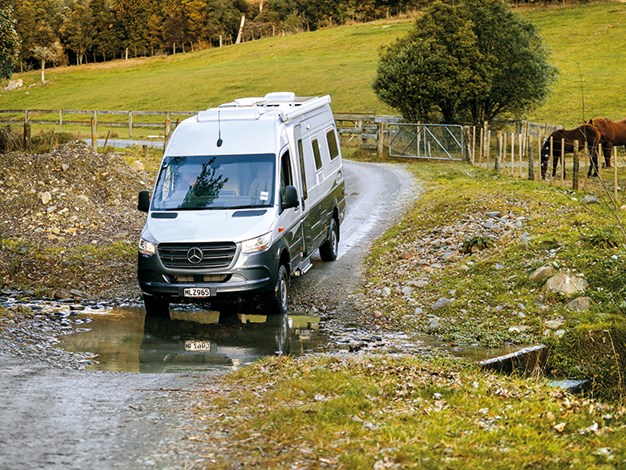 |
|
The Campro Revolution 4WD in its element
|
Campro have been building their Revolution model for a number of years now, and have produced more than 50. While they have a standard layout/specification, each one is customised to some extent by the buyer’s requirements.
Two base vehicles are offered; Fiat or Mercedes. Campro’s unique feature is the hinged side door that replaces the regular sliding door. They have a module to fit the Ducato and another that fits the Sprinter, hence the brand limitation; Fiat or Mercedes.
The Revolution being reviewed is built into a 4WD Mercedes Sprinter 319. Being 4WD it had to be imported especially for the customer. Currently, this adds around five to six months to the delivery time and increases the price about $22,000.
Grant and Debra, the buyers, were happy with that; happy to have the peace of mind the 4WD offered. They planned going places where getting ‘stuck in the mud’ was a real possibility. Grant and Debra surveyed the marketplace options before deciding on Mercedes and Revolution. Replacing the whizz-bang sliding door with a hinged door promoted the Revolution up the pecking order. The Ducato disqualified itself as it was not available in 4WD. Anyway, Mercedes’ easy driving style had won Debra over and Grant had his 4WD option so the Mercedes/Revolution combination won the day. They elected to go with the 3500kg GVW/WOF option and accepted the smaller payload.
Grant opted for the 190HP three-litre V6 diesel motor driving the rear wheels through a nine-speed automatic gearbox to go with the 4WD option. Another 4WD benefit is ground clearance; it has more than that found on the standard Sprinter. Together these features open up an array of places they can travel to without worrying about getting stuck, even if/when they are towing a boat.
Sure, the supply time delay is a nuisance, but it allowed them to option the Merc to their own specifications. Their final Revolution package price – just over $200K.
Externally the Mercedes looks sharp in its two-tone suit, metallic grey over graphite with pinstripes of red and graphite and decal swirls where the colours meet. A discreet 4WD badge, as well as the extra ground and wheel arch clearance (around 85mm), announce the feature that distinguishes this Revolution from the 50-plus that have gone before it.
It is nice to see all the white fittings like the toilet hatch and the fridge vents painted graphite to match the bodywork, making them anonymous rather than a feature. A dual bike rack has been fitted to the rear door, driver’s side. Previously Debra was involved in the bike industry and she still enjoys bike riding, with occasional electrical assistance.
Layout
It is a practical, versatile interior layout. The cab seats rotate 180 degrees to face the rear. Along with the two-seater settee opposite the entrance and a small dining table, they create a convivial entertainment space for four. That’s very useful when the twin settees at the back of the RV are made up as a double bed as it can be left that way for long periods without any real inconvenience.
Eating and entertainment can both be conducted up front. Amidships the kitchen is kerbside with the washroom opposite. At the back are twin settees, one each side. Across the back, a cushion closes the gap between the settees. At nighttime the settees can be used as single beds or converted to a large double. When the rear of the Revolution is in lounge mode the table can be relocated there.
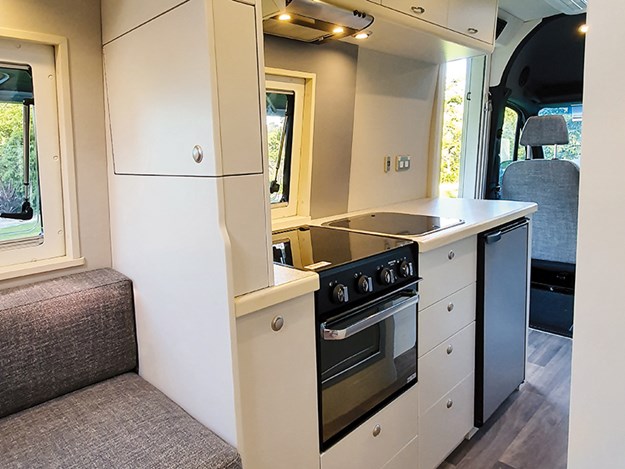 |
|
In this version, the TV cabinet is at the end of the kitchen bench
|
Kitchen
The kitchen is galley-style with the bench kerbside between the entrance and the lounge. Around 1750mm long, the bench is bigger than those found in much larger motorhomes. Both the three-hob cooktop and sink are set into the benchtop to the right, and both have hinged glass lids that augment the worktop space. Left of the sink is an 800mm length of clear worktop.
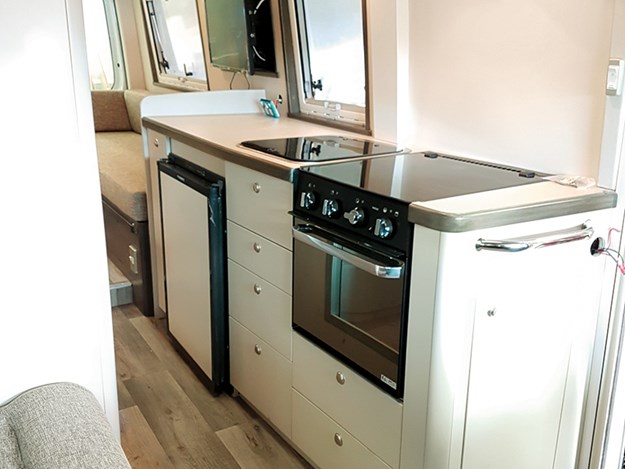 |
|
The enormous galley kitchen – lots of space to get creative
|
Storage space is excellent, with a Dometic three-way fridge with six drawers below the bench, and four lockers above. A couple more overhead lockers up front over the front side settee are available if needed. And if you are cooking up a storm, you shouldn’t have any issues with the steam and smells; a large roof hatch and an externally vented range hood take care of these.
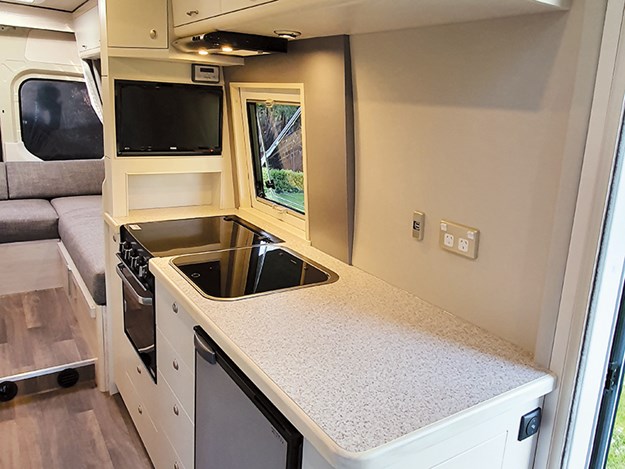 |
|
There is excellent overhead locker storage
|
Lounge
Twin settees, one each side, double as two single beds or a very large double. Making up the double bed is a simple process. Timber slats that pull out from the rear locker bridge the gap and the settee back cushions become the mattress. The upholsterer who made the cushions referred to the foam as ‘elephant’ foam, and Debra reports that while it is firm it is also very comfortable. A grey ‘linen-look’ synthetic fabric has been used to cover all the cushions as well as the cab seats. A fitted carpet in a darker shade of grey covers the floor.
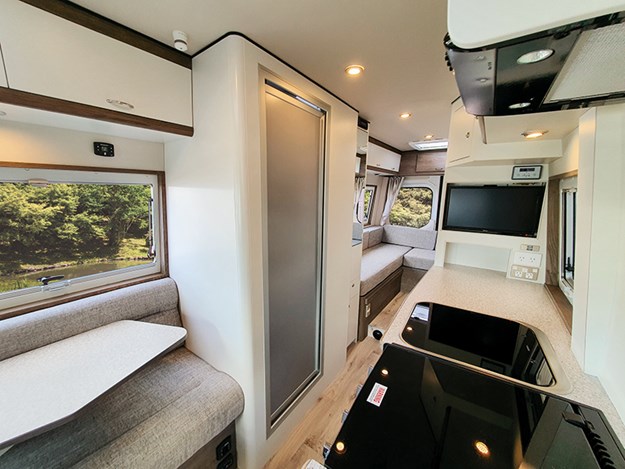 |
|
The front settee and table are alongside the washroom
|
Conventional curtains cover the rear door windows. Being fixed to the RV body rather than the doors, they can be drawn whether the doors are open or closed. Windows either side of the lounge (and throughout the RV) are the cassette style, awning hung with built-in blinds and insect screens.
Ample storage is provided; under the settees and in the seven overhead lockers, three each side and one across the back. The LPG bottle locker is under the rear seat cushion between the settees. This arrangement left the seat cushions uncomfortably high off the floor, so the floor was raised to make the seating user-friendly, hence the step.
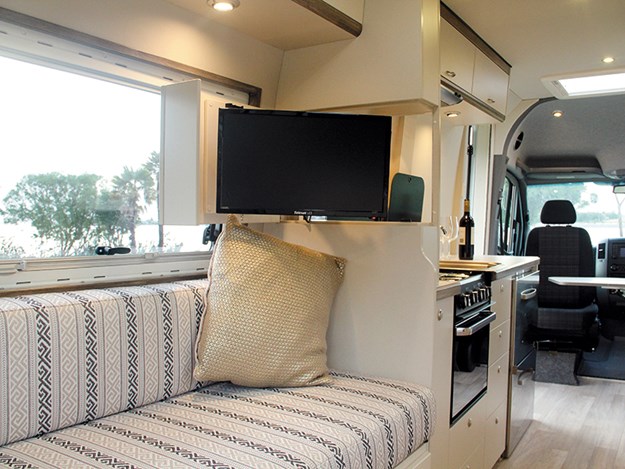 |
|
Grab a seat and take time to chill out
|
Beside the shower door is a narrow cupboard, a drawer and hanging locker as well as a decent mirror. Each side, under the overhead lockers, are a pair of reading lights and an entertainment centre speaker.
A television is wall-mounted where the kerbside bed meets the kitchen cabinet. Neatly recessed into the wall behind the TV is the control unit for the Southern Cross automatic satellite receiver dish.
Debra decided against fitting the TV cabinet at the end of the kitchen bench. She felt it made the interior feel smaller.
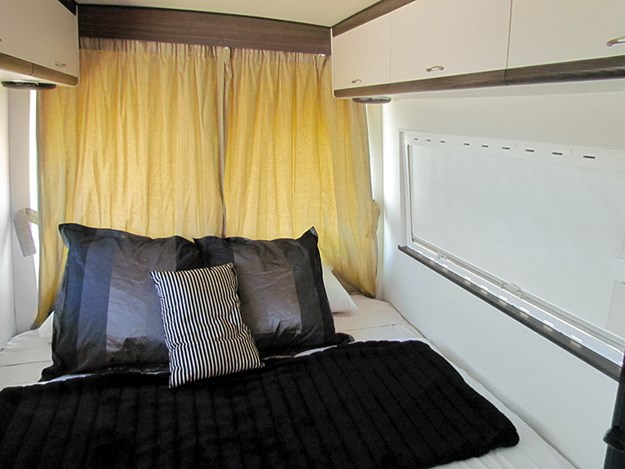 |
|
The rear in bedtime mode
|
Washroom
Contained within the shower compartment is a Thetford swivel bowl toilet and a corner handbasin. The walls are clear of fittings so they are easy to wipe down. A dual purpose basin tap also serves as the shower handpiece, with the water flow and temperature controlled by a single tap lever mounted on the side of the handbasin. A medicine cabinet with mirror doors is wall-mounted above the toilet. Winter warmth is via a wall vent connected to the heating system, ventilation is courtesy of a ceiling hatch, and a cover on the roll holder keeps the toilet paper dry. There is no denying the washroom is compact, but it does the job.
Entry
Mounted kerbside the Fiamma 3.5-metre awning is well placed to protect the habitation door and surrounds from the rain. Wide, sturdy steps on both the side and rear doors o set the extra height caused by the 4WD configuration. The entry door, a 500mm wide Hartnell, is fitted with a window, a blind and rubbish bin. It is backed up with a sliding door/insect screen, which is extremely useful when touring in South Island sandfly country.
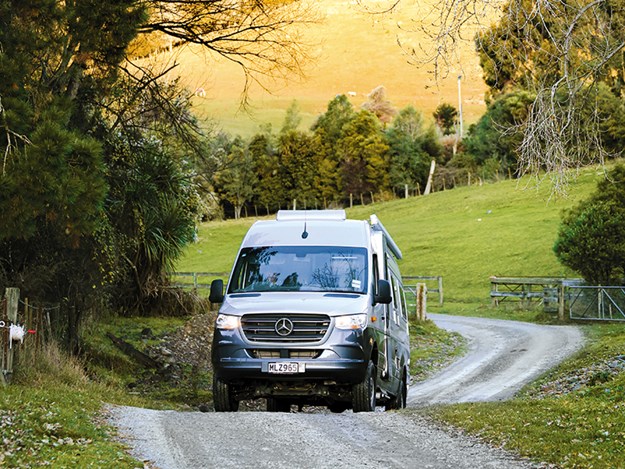 |
|
Let the adventure begin…
|
Cab
A standard Sprinter dashboard with minimal instrumentation keeps driver distraction to a minimum. More features can be programmed to show on the display, but the standard display is all that’s needed. Lining the ceiling is a one-piece moulded headliner with two shelves, one each side above the sun visors, along with a downlight and an entertainment system speaker each side. The cab seats are well padded and the seatbelts are built into the seat, making them practical and comfortable to use. It is worth noting that the floor is flat from the cab through to the lounge, where it is one step higher. Being a seating/sleeping area rather than a transit corridor, the higher floor is not a problem.
The ‘Go-Anywhere’ Gear
I did not get to try the vehicle in all-terrain mode, so be sure to test-drive before you buy. Engaging the 4 x 4 system appears to be straightforward. At slow speed, 10km/hr or less, the press of a dashboard mounted tumbler switch engages the Mercedes 4ETS all-wheel drive system. This system is integrated with the Sprinter’s ESP Electronic Stability Programme. The all-wheel 4 x 4 drive and the safety systems work together perfectly, remaining operational while the all-wheel drive is engaged. Engaging the low range gearbox is also done by pressing a button. This time the vehicle must be stationary, with the engine running and the 4 x 4 engaged. It reduces the transmission ratio by a factor of 1.42 (42 percent), so the road speed drops but the torque increases.
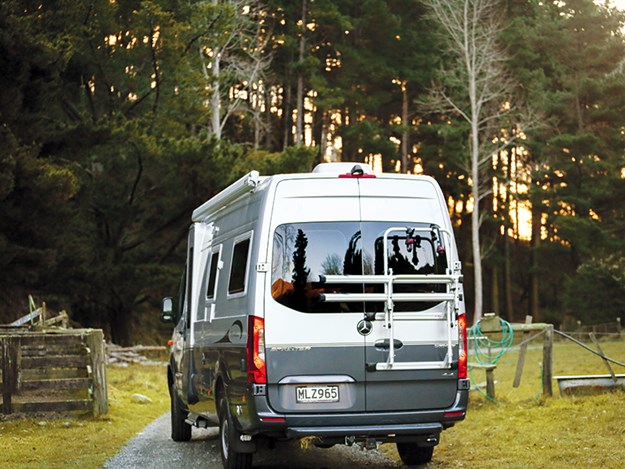 |
|
Note the single door structure under the front of the awning on the left-hand side
|
Summary
This is how Debra summarised the 4 x 4 Revolution: “The bed is comfy, I think the fridge is a good size, and the shower is small but the workmanship throughout is excellent.” And Debra should know. She and husband Grant have lived in it for a month or more since they took delivery.
Campro Revolution 4WD specifications
| Chassis | Mercedes Sprinter 319 |
| Engine | 3-litre turbo-diesel Euro 6. 190bhp |
| Gearbox | 9-speed torque converter gearbox. |
| Berths | 2 |
| Length / width /height | 6967mm / 1995mm / 2905mm inc satellite dish. |
| Fresh/hot/grey water | Fresh 125L / grey 115L / hot 13L |
| GVW | 3490kg |
Price as reviewed: Just over $200,000
PROS
- Side door in place of a slide door.
- No more whizz… bang!
- Excellent layout, particularly the front cab lounge area
- The large, robust external steps
CONS
- Nil
For more information check out campro.co.nz
Find motorhomes, caravans and RVs for sale in NZ





